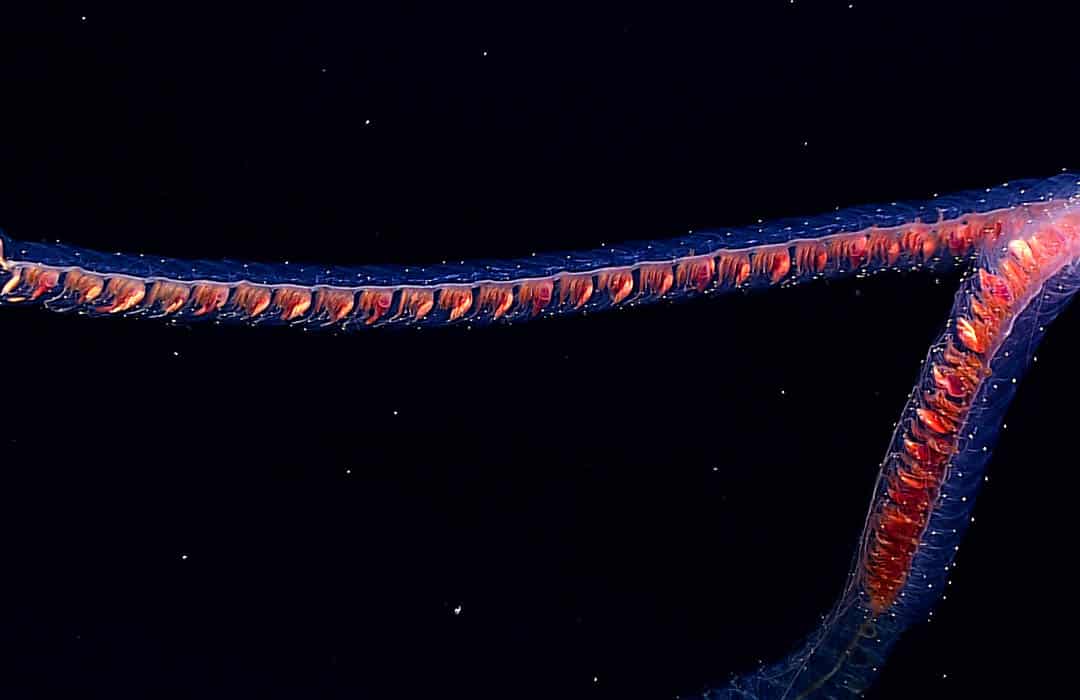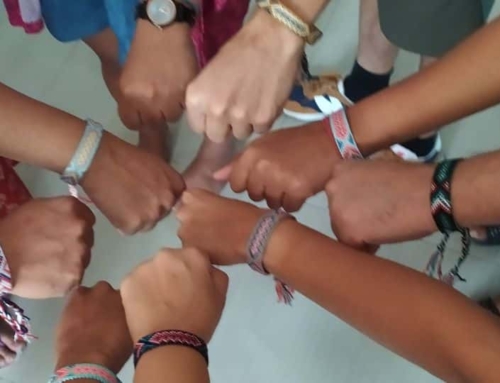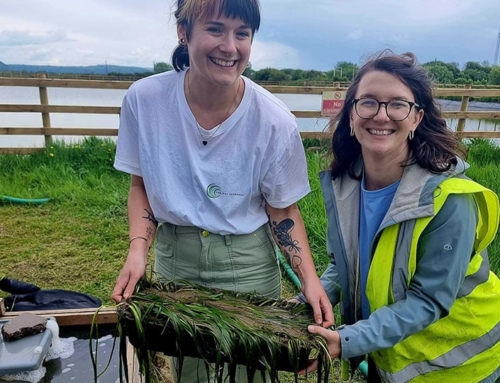An Interview with Dr Helen Scales
Dr Helen Scales is a writer, marine biologist and broadcaster. She is currently writing a book on Earth’s ‘final frontier’: the deep ocean. From a young age, Helen has been a passionate nature-lover and she fell hopelessly in love with the ocean after seeing it for the first time from beneath the waves. She has studied and worked as a marine conservationist, living and working in many countries where she’s witnessed the breathtaking wonders of the oceans, as well as the threats they face.
What made you decide to focus on the deep ocean for your latest book?

Marine biologist, author and broadcaster Helen Scales. Image: Ria Mishaal
The books I’ve written so far have mainly focused on particular groups of ocean creatures like seahorses and molluscs and their shells. This time I decided to concentrate on a place, specifically the depths of the ocean below the top two hundred metres – the deep sea.
I was inspired to focus on the deep for a couple of reasons. First and foremost, the deep is where the most exciting, revolutionary discoveries in our living world are being made.
Helped by incredible technological advances, scientists are exploring more of the deep oceans than ever before. There are now deep-diving robots that ping back high-definition, live video of what’s down there. Self-steering submersibles can navigate themselves through the deep for months and years at a time, gathering data as they go. Equipped with these cutting-edge tools, deep-sea scientists are without doubt the greatest modern-day explorers. They look into parts of the planet where nobody has been before, and all the time they’re making amazing new findings and learning more about how these deep ocean ecosystems work.
Our view of the deep oceans is growing more detailed every day, but at the same time humans are increasingly impacting the deep. That’s the other reason I want to write this book. Human activities are reaching deeper than ever – from deep-sea fishing to the rain of pollution and plastics, most of which goes unseen.
So, my book will reveal the tremendous biological wonders of the deep, while at the same time showing what we’re doing to this distant realm.
This is a pivotal time in history for this huge, deep part of our planet. Up until now, humanity has focused on the surface seas – for thousands of years, people have travelled across the oceans and fished the shallower seas. I think the ocean of the future is the deep sea. This is where people will be looking more and more, to feed ourselves and find solutions to many of the problems we face out here on land, and also to make those mind-blowing discoveries that are telling us so much about life on earth.
There’s a cliché about us knowing more about the surface of the moon than the deep ocean. What kind of challenges do you face when writing about an area about which so little is known, and which is so hard to visit?
Yes, it is difficult, and I don’t think I quite appreciated how difficult it would be! I’m often asked whether I’m going to go into the deep, but the truth is, very few people do. Even among deep-sea biologists, only a very small minority actually get to visit the depths of the ocean. Alvin and a few other human occupied submersibles still do amazing work, but so much research is done remotely now.
It is a challenge being removed from this place that I’m writing about. I have often felt very distant from my subject matter, but maybe that’s the point: it is a distant place. My job is to find ways to connect readers to it. It’s easy to think that it’s all just muddy, flat abyssal plains, but in reality, the habitats (even the muddy ones) are incredibly rich – but in ways that are totally different to what we see out on land. Getting my head around things like chemosynthetic communities that function in the pitch dark has bent my brain a bit, but in a good way!
The deep ocean is such a vast space – how does your book begin to approach such a huge subject?
When it comes to the deep sea, it’s difficult to wrap your head around the different scales involved. On the one hand, it’s this truly massive space. The ocean covers 70 per cent of the surface of our planet and the average depth is just under 4km and this makes it the single, biggest living space on the planet – around 90 per cent of the biosphere is the ocean. And a huge part of that is the deep sea, deeper than 200 metres.
There’s this old idea that the deep sea is just a vast, empty space, but of course it’s not – it’s full of life. All the way down there are organisms exquisitely adapted to the different depths, from the delicate animals wafting around made of jelly with twinkling lights, to the strange worms that specialise in eating the bones of dead, sunken whales on the deep seabed.
So, in the book, as well as trying to get a handle on the huge size of the deep, I zero in on the details, on the stories and characters that I hope will bring it alive to readers.
As a part of that, I also want readers to appreciate that some important parts in the deep are not nearly so big. In fact, there are habitats that are actually relatively small. Take the hydrothermal vents, which were only discovered forty years ago. They are bustling with all sorts of weird animals like snails with shells made of iron, or Yeti crabs that survive by eating the bacteria they farm in their furry arms. There are fewer than 400 known hydrothermal vent fields, and each one is not especially big. The vents from the Indian Ocean would all fit inside 34 football fields. So, those ecosystems are not huge but they are incredibly important. They revolutionised how we think about life on earth, thriving down in the dark deep.

Hydrothermal vent chimney: NOAA Office of Ocean Exploration and Research
What are some of the most extraordinary creatures you’ve encountered while doing your research?
There’s so much down there, it’s hard to choose. Lately, I have to admit I’ve become a little bit obsessed with bone-eating worms! They were discovered by accident twenty years ago when a research team stumbled across a dead whale on the deep seabed, and noticed that its bones were being eaten by a type of worm nobody had ever seen before. And these are not just any old worms – they’re distant relatives of earthworms but in fact they look more like plants. They have roots which burrow into bones and dissolve them.
Since their discovery, dozens of species of bone-eating worms have been found, but they have only been seen on bones. They just show up when there’s a skeleton and nobody knows how they find them or where they hang out the rest of the time. The bone-eating worms also have very strange sex lives. For most species, the males are tiny compared to the females. The females live inside a tube and she has a harem of dozens of microscopic males tucked in there, ready to fertilise her eggs as soon as she lays them. In the big, deep sea it’s useful to hang onto your mates!
I’m also fascinated by the phenomenon of marine snow – it’s mostly made up of dead plankton, plankton poo and bits of organic matter that form white fluffy clumps and drift down to the sea bed. And it forms a really important source of food in the deep sea. Loads of animals eat it, including all sorts of delicate, gelatinous creatures that for a long time were really tricky to study – try and catch one in a net and they fall apart.
Marine snow itself is also really delicate stuff. If you made a snow globe with it and shook it, the snow would just crumble into dust. So, research has come a long way since the arrival of remote operated submersibles and other gadgets that allow researchers to see snow, and the soft, delicate animals that eat it, including all sorts of jellyfish and intricate siphonophores that grow in great long strings like feather boas. We need to have eyes in the deep to see these things properly. Bring them to the surface and they turn into a featureless handful of slime.

Siphonophore: NOAA Office of Ocean Exploration and Research, Hohonu Moana 2016.
I recently accompanied a group of deep-sea researchers on a trip in the Gulf of Mexico. One of the deep-sea species that lives there is the vampire squid, and they are very cool animals. With a name like that, they sound pretty terrifying and you might expect it be some kind of blood-sucking creature, but in reality they are very gentle – they just eat marine snow. They float in open water and reel out a long filament which marine snow settles onto – they fish for snow! – then they draw the filament into their mouths, wipe off the snow and that’s their food.
A point I want to make in the book is that the deep sea can feel like this alien, unearthly place, because the creatures living there are so strange and different to what we’re used to seeing on land and in shallower seas. But of course they’re not aliens. If anything, they’re more earthly than we are, given that they occupy the biggest living space on the planet. We’re the weird ones for living out on scraps of land!
How can our activities threaten this seemingly endless expanse? Can you give us an overview of the activities that are currently threatening the deep ocean?
There’s a lingering idea that because the oceans are so huge, they are an endless, untouchable space – we can throw in as much rubbish as we like, take out as much food as we like, and it will be fine. But we are having a huge impact.
As I say, I think in future, humanity’s focus on the oceans is going to go deeper and deeper. We are already fishing further from shore and deeper down than we used to, because species in shallower, more accessible seas are being overfished. The problem is that fish in the deep are commonly very long-lived. There’s Orange Roughy, which live for hundreds of years and don’t start breeding until they’re thirty or forty. Sustainably hunting a two-hundred-year-old fish is not really economically feasible, and there is a terrible history of overfishing of that species, and many others down in the deep.

Orange Roughy: NOAA Office of Ocean Exploration and Research
We know that the impact of pollution and plastics extends all the way down into the deep. We’re finding plastics at the bottom of the deepest trenches. But we don’t yet fully understand the impact that’s having on these ecosystems.
There are also new threats on the horizon. One of the most worrying is deep-sea mining. There are plans afoot to open the first mines on the deep seabed for minerals and metals which many mining companies are saying will be vital to make solar panels, wind turbines and electric car batteries. Hydrothermal vents are a potential target for these mines and more and more scientists are agreeing that it could be disastrous if we lose species and habitats that still have so much to tell us about life on earth.
We already have so many problems to deal with in the oceans, it seems crazy to add a whole new one, especially when we’ve no idea really what the upshot will be, what impacts and troubles deep-sea mining might unleash.
It may seem distant from us but the deep reaches into our daily lives – it absorbs carbon and heat from the atmosphere, helping to stave off the worst effects of the climate crisis, and nourishes the shallow plankton that produce half the oxygen we breathe. And in the future, there could be important new medicines based on findings in the deep – scientists are already searching deep-sea corals and sponges and finding chemicals in them that look promising as the basis for new types of antibiotics that are effective against superbugs, like MRSA. Who knows what else we might find in the deep?
If there was one thing that you wish more people knew about the ocean, what would it be?
I’d love people to know just how abundant and extraordinary life is in the deep. Sure, it’s dark and cold down there, but it’s by no means empty. It’s not an oceanic desert, but a flourishing world that we are still learning so much about.





